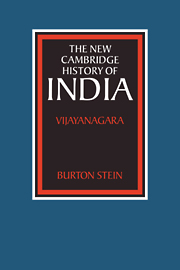Book contents
- Frontmatter
- 1 Introduction
- 2 The medieval past: continuity and disjunction
- 3 The city and the kingdom
- 4 Political economy and society: the sixteenth century
- 5 Imperial collapse and aftermath: 1542–1700
- 6 Conclusion
- Bibliographical essay
- Index
- THE NEW CAMBRIDGE HISTORY OF INDIA
- Frontispiece">
- Plate Section">
2 - The medieval past: continuity and disjunction
Published online by Cambridge University Press: 28 March 2008
- Frontmatter
- 1 Introduction
- 2 The medieval past: continuity and disjunction
- 3 The city and the kingdom
- 4 Political economy and society: the sixteenth century
- 5 Imperial collapse and aftermath: 1542–1700
- 6 Conclusion
- Bibliographical essay
- Index
- THE NEW CAMBRIDGE HISTORY OF INDIA
- Frontispiece">
- Plate Section">
Summary
If the interpretative lead of S. Krishnaswami Aiyangar and some historians of Maharashtra is followed, then Vijayanagara was the precursor of and the precedent for the Maratha state of the seventeenth century. Yet, Vijayanagara was also a medieval south Indian kingdom, one of about fifty royal houses whose inscriptions and whose sovereign claims extended over more than one of the linguistic, or cultural, regions of the peninsula from the time of the Chalukyas of Badami. Some sixty Vijayanagara rulers issued royal inscriptions claiming universal authority throughout the peninsula south of the Krishna River. In addition, there exist royal inscriptions of another twenty ruling families who acknowledged the overlordship of Vijayanagara kings, and another forty or so independent ruling families left inscriptions asserting sovereignty over some peninsular territory in the Vijayanagara age.
This multiplicity of sovereignties is very likely an underestimate, and it poses one set of confusions. Another arises from the fact that kings of Vijayanagara were of four distinct ruling lineages; they differed in language and provenance, in their religious affiliations and even in where their capitals were after the catastrophic sack of Vijayanagara in 1565. A beginning point in ordering that history is the founding of the fortified city on the Tungabhadra around 1340; a possibly earlier beginning point may well be the onset of the incursions of soldiers serving the Khalji sultans of Delhi, which allegedly created the reasons and conditions for the new dynasty and city of Vijayanagara.
- Type
- Chapter
- Information
- The New Cambridge History of IndiaVijayanagara, pp. 13 - 30Publisher: Cambridge University PressPrint publication year: 1990

